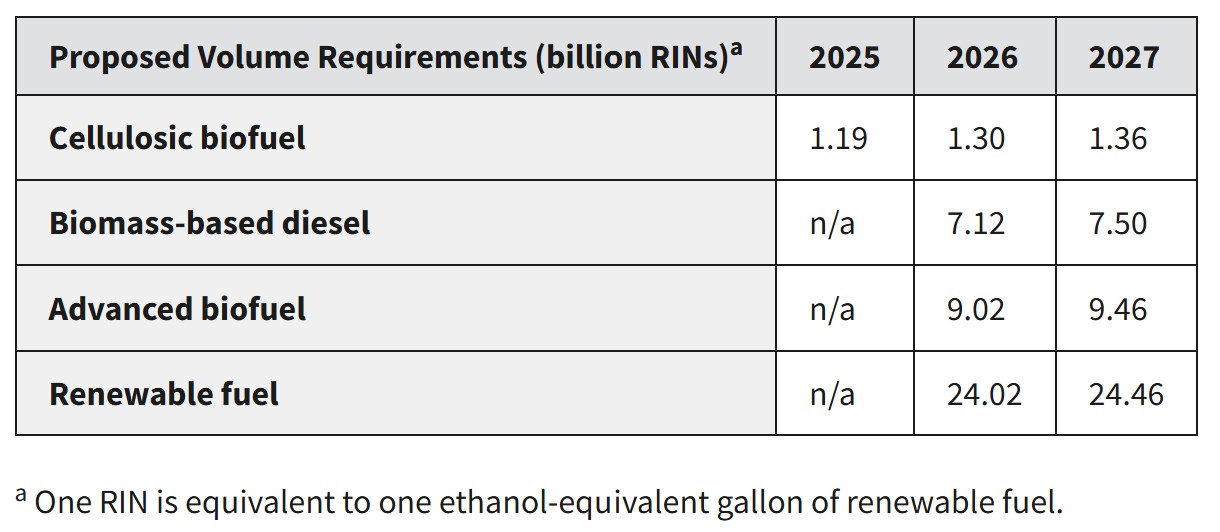On June 13, 2025, the EPA introduced a proposed rule to set Renewable Fuel Standard (RFS) volumes and percentage standards for 2026 and 2027. The proposal also includes a partial waiver of the 2025 cellulosic biofuel volume requirement, due to lower-than-expected production, along with a few notable regulatory updates. These include reducing the number of RINs generated for imported renewable fuel and fuel made from foreign feedstocks, as well as removing renewable electricity (eRINs) as a qualifying fuel under the RFS program.

To gather feedback, the EPA held a virtual public hearing on July 8, 2025. RINSTAR tuned in and put together a summary of the testimonies we found especially interesting or unique. The EPA noted that an official transcript of the hearing—and their responses to public comments—will be made available at a later date.
You can find more details about the proposal here.
___________________________________________________________________________________________________________________________
Emily Skor – CEO, Growth Energy
Emily Skor applauded the EPA’s proposal as the strongest RFS rule to date. Representing 97 ethanol producers, Skor emphasized the benefits of the proposed 15 billion gallons of conventional ethanol blending for both 2026 and 2027. She stressed the importance of certainty for investors and rural economies and urged the EPA to maintain firm policies on Small Refinery Exemptions (SREs). Skor stated “Most importantly, the agency must finalize this proposal while making it clear that SREs will not be granted recklessly and that any gallons lost to SREs will be made up in the market.” Skor also advocated for clearing the backlog of pathway approvals and ensuring year-round E15 access.
Geoff Cooper – CEO, Renewable Fuels Association (RFA)
Geoff Cooper offered full support for the proposed RVOs, praising the 15 billion gallon ethanol targets and recognition of corn kernel fiber’s potential. He supported the 50% RIN reduction for imported fuels, emphasizing the importance of domestic production, stating “RFA strongly supports EPA’s proposed 50% reduction in RINs generated for import-based renewable fuels. We fully agree with the EPA that there are ‘reduced economic, energy security, and environmental benefits’ provided by imported renewable fuels.” He also urged the EPA to ensure SREs are granted only when truly justified, and that exempted volumes are accurately reallocated.
Brian Jennings – CEO, American Coalition for Ethanol (ACE)
Brian Jennings welcomed the proposal, particularly its multi-year RVO structure and preservation of blending volumes. He encouraged EPA to consider higher biomass-based diesel volumes to offset past market distortions and shared ACE’s efforts with the USDA to enable low-carbon farming practices to qualify for tax credits. Jennings emphasized aligning RFS policy with carbon intensity scoring to unlock new market opportunities stating “We welcome EPA’s request for comments on the link between low-carbon farming practices and new markets for ethanol. In partnership with USDA, DOE, 13 ethanol companies and hundreds of farmers, ACE is currently leading a project to unlock new markets and tax credits such as 45Z based on low-carbon farming. Once farmers participating in our project have adopted USDA-approved low-carbon practices, we will collect soil samples and other field-level data to fine-tune models and generate more reliable CI scores, essentially solving for information gaps which currently prevent farmers and ethanol producers from monetizing AG practices through fuel markets. We will share more on this project and other topics covered in EPA’s proposal in our written comments.”
Dr. Fred Turatti – Senior Director of Fuel and Vehicle Policy, AFPM
Dr. Fred Turatti expressed support for EPA’s removal of eRINs. Turatti stated “AFPM supports EPA’s proposal to remove renewable electricity as a qualifying renewable fuel. The law does not permit e-rins and we appreciate that the EPA is taking steps to recognize this straightforward statutory limit.” He also raised concerns over the feasibility of biomass-based diesel increases due to feedstock limitations and predicted that RIN prices could rise under the import RIN reduction policy. Turatti stressed the need for regulatory certainty, especially regarding how SRE volumes would be managed.
Randy Beck – Senior Director of Renewable Energy, WM
Randy Beck emphasized WM’s $1.6 billion investment in RNG infrastructure and highlighted the continued growth of landfill RNG. He expressed concern about the proposal’s assumption of market saturation and the negative impact on D3 RIN prices. Beck stated “These investments are due to the recent stability in D3-RIN pricing. Unfortunately, the market’s reaction to the agency’s proposed set rule is leading to downward pressure on the price of D3-RINs and may disincentivize future RNG investment.” Beck urged the EPA to adjust its assumptions about CNG vehicle demand and reconsider the 50% RIN reduction, advocating alignment with the One Big Beautiful Bill provisions.
Kate Shenk – Director of Regulatory Affairs, Clean Fuels Alliance America
Kate Shenk praised EPA’s return to scheduled rulemaking but raised concerns about unresolved SRE petitions and their potential to disrupt the biomass-based diesel market. She called for a high threshold for granting SREs and insisted that RINs returned from retroactive SREs should not count toward current compliance with Shenk stating “We ask that RINs from granted SREs cannot be added as carry over RINs for previous RVO years. If EPA returns RIN credits to the small refiner whose SRE petition was previously denied and if those RIN credits are available for compliance with current our future RFS obligations, the result would be devastating for renewable fuel producers.” She also stressed the need to finalize these decisions before releasing final RVOs.
Elias Peterson – Representative, Kolmar
Speaking for American Green Fuels, Elias Peterson endorsed the proposed 5.61 billion gallon BBD target and emphasized the importance of maintaining that level. He noted that the existing North American feedstock capacity can meet the goal and warned that any changes to import-related RIN values or SRE policies should not undermine the standard. Peterson stated “EPA should not allow the noise surrounding imported fuel and feed to cloud the reality of the 5.61 billion gallon target for the domestic industry.”
Monte Shaw – Executive Director, Iowa Renewable Fuels Association (IRFA)
Monte Shaw supported the robust two-year RVO plan, saying it provides much-needed market stability. He encouraged EPA to take bold action in approving the proposed volumes and to err on the side of higher targets. Shaw stated “We urge the EPA to lean in. I spoke last fall with an EPA senior official who told me, ‘Hey, we can reduce these numbers. We did it during COVID, you have it in this rule with the cellulosic, but we can’t increase them.’ So, lean in, if you’re going to err, err on the side of high, because you’ve shown that you have the authority to reduce RVO numbers.” Shaw reiterated the importance of addressing outstanding SREs and advocated for continued progress on nationwide adoption of E15.
Jessi Frend – Senior Policy Advisor, Sigma
Jessi Frend expressed appreciation for the RFS structure but voiced concern about the proposed shift favoring domestic over imported fuels. She cautioned that this could increase retail fuel prices and disadvantage coastal markets, stating “This will hurt marketers and consumers in coastal markets. Companies in these regions have come to rely upon imported fuels and feedstocks to satisfy demand that the domestic biofuel industry is not prepared to meet.” Frend called for careful consideration of how tax policy and demand-side incentives intersect with compliance burdens.
Heather Dziedzic – Vice President, American Biogas Council
Heather Dziedzic questioned the low growth projections for D3 RVOs, given the 25% year-over-year RNG growth. Dziedzic stated “At this rate, the 2025 RVO of 1.38 billion is well within reach and at risk of being exceeded.” She advocated for revised volumes using newer DOE data and highlighted the need to accommodate emerging CNG engine technologies. Dziedzic also urged EPA to eliminate the 2025 waiver and to consider how to respond if actual biofuel generation exceeds RVOs.
Angela Foster-Rice – Vice President of Government Military Affairs, LanzaJet
Angela Foster-Rice discussed LanzaJet’s SAF plant and economic contributions to rural Georgia. She warned against penalizing U.S. producers through outdated lifecycle assessments (LCA) and emphasized the need to update LCA models to reflect current agricultural practices. She stated “The fundamental issue that has prevented the approval of the use of domestic feedstocks to rate RINs [is] the current RFS LCA methodologies. They have not incorporated peer-reviewed scientific changes the carbon intensity values have been made by U.S. farmers and ethanol producers. This is problematic as EPA is effectively using outdated information to make decisions, therefore, penalizing U.S. farmers and producers.” She also urged that SREs be fully reallocated to maintain market integrity.
Dan Lashof – Senior Fellow, World Resources Institute
Dan Lashof echoed concerns about overreliance on food crops and land use emissions. He questioned the EPA’s justification for high volume increases, citing a $6.5 billion cost versus $202 million in benefits. Lashof urged the EPA to reject volume increases beyond 2025 and rely instead on lower-volume scenarios that align with its own analysis. Lashof stated “While the EPA is not required to do a full-cost benefit analysis for this rule, it surely needs to provide some justification for imposing costs that exceed benefits by more than a factor of 30.”
___________________________________________________________________________________________________________________________
The July 8 hearing made one thing clear: the proposed RFS volumes for 2026–2027 have stirred up strong opinions across the board. Many biofuel producers welcomed the rule as a step forward for industry growth and market stability, while others voiced concerns about the economic, environmental, and regulatory impacts. While RINSTAR may not align with every viewpoint shared, we value the diversity of perspectives brought to the table. As the EPA works toward finalizing the rule, they’ll need to carefully navigate through these differing perspectives to keep the RFS program strong and sustainable for the long haul.
At RINSTAR, we’ve been tracking the Renewable Fuel Standard for more than 15 years, and we’re committed to keeping you informed as the program grows and changes. Be sure to explore our latest blog posts for timely updates—and don’t forget to subscribe to our newsletter to stay up to speed on everything happening in the renewable fuels space.
